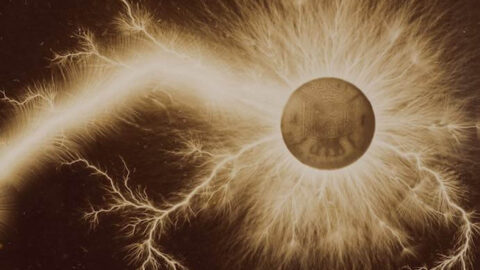Explosive tendrils of electricity branching chaotically from the edges of a coin is the image of Étienne Léopold Trouvelot’s Electric effluvia on the surface and circumference of a coin. Such is the fitting choice of album art for Elliott Sharp’s The Boreal. A compilation of four pieces composed between 2004 and 2009, The Boreal features performances by the JACK Quartet, pianist Jenny Lin, Orchestra Carbon, and the Janáček Philharmonic Orchestra. Avoiding a sense of musical narrative, Sharp’s music implicates notions by experimenting with various composites and fusions of sound. The product, though primal and turbulent, is nonetheless cleverly designed—Sharp acting as a conduit to his own chaos.
Despite the composer’s reluctance to assign program to his music, Sharp’s opening act, The Boreal, performed by the JACK string quartet, assumes significant meaning from its very title. The composer indicates influences such the prehistoric northern Boreal Sea, the Holocene era’s Boreal Period, and the frigid ecosystems of Earth’s poles. Indeed, the otherworldly soundscape of The Boreal reflects the ancient stirrings of life brewing in Earth’s primordial soup. For this alien sound, Sharp devised alternative bows using ballchain and metal springs—materials which, when strung across the stringed instruments, create a tortured drone of creaks and groans. In the second and third movements, the voices slither in tangled glissandos phased out-of-sync. At unexpected intervals, the instruments shift into unison, sustaining harmonies in the upper register. There is no levity in Sharp’s primal world. It is a primitivism reminiscent of Stravinsky—though The Boreal reaches further than harsh Russian pagan rites, devolving to the volatile struggle for order at the dawn of life. At the piece’s conclusion, Sharp’s exotic, metallic bows fade into the shadows, their chittering static dying in desolate cold.
Oligosono, featuring Jenny Lin on piano, continues the premise of instrumental experimentation left by The Boreal. Like the album’s introductory piece, Oligosono is episodic, made up of many short ostinati and Henry Cowell-esque tone clusters, without a central theme or tonality. Nevertheless, the passages occasionally link together. Sustained notes from one sequence’s conclusion merge into the next—the residual overtones creating an ethereal microtonal atmosphere.

Proof of Erdős, Sharp’s musical tribute to mathematician Paul Erdős, is a auditory experiment—exploring different sounds through combination and permutation. The instrumental voices of Orchestra Carbon demonstrate an innovative approach to additive process. Instead of building asymmetrical tonal chords, Sharp has his musicians assemble and mix various noises beyond the conventional usage of orchestral instruments. Among these constructs, heavy-handed, scratchy bowings drone in the lower register, combined with open-stringed strumming in the violins. The result, often unpleasant, nevertheless evokes a sense of anxiety and panic.
Sharp’s conclusion, performed by the Janáček Philharmonic Orchestra, offers a reprise from the arcane subject matter of the previous three entries. On Corlear’s Hook derives its name from the eponymous diverse neighborhood in Manhattan. The piece features a plethora of sonic images, illustrating the bustle of city life. Sharp experiments with various drones that persist in the background: low-register piano trills murmur in the first movement, and, at other times, certain voices maintain a constant singular tone in perpetual motion. The composer confounds any sense of time organization by combining these ostinati—each of which maintains its own rhythm. The result is a cacophony representative of chaotic movement: the sounds of life, the sounds of Earth.
























